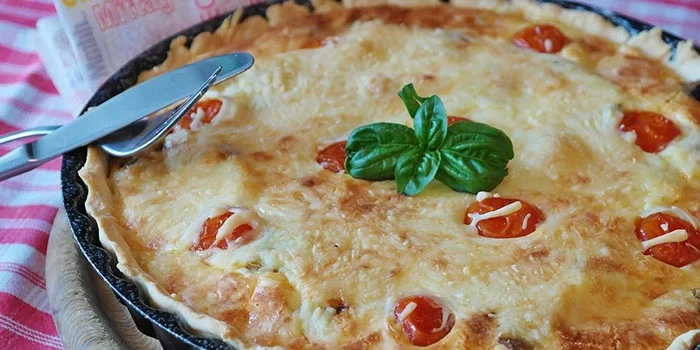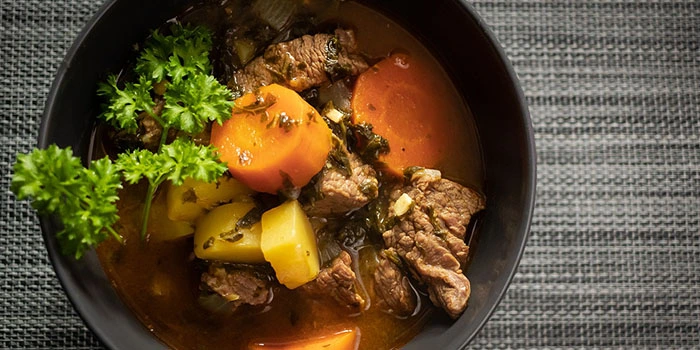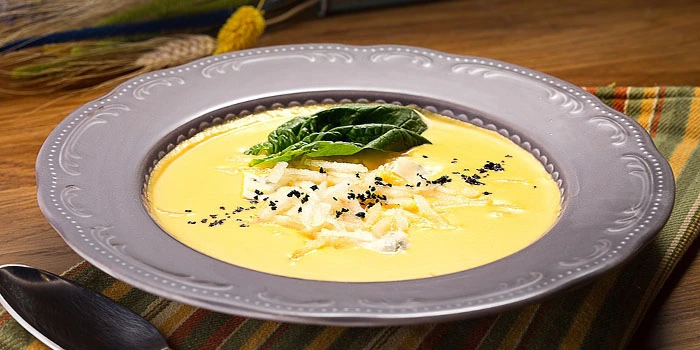Introduction
Imagine having the perfect quiche for late breakfast on a lazy Saturday. But in real life, after taking it out of the oven, you find it watery.
But worry not! We have some tips and tricks up our sleeves that will save your day! And your quiche will be perfect just like you imagined!
Now, how to fix a watery quiche?
It all depends on where you went wrong! Because not all mistakes are fixable. However, you can try reheating a quiche at the same temperature. Reheating with aluminum foil is also a very good trick. However, an overcooked quiche requires a hot water bath. If nothing else works, try draining or soaking the excess moisture.
These are some simple ways to fix your quiche. But there’s more, so what are you waiting for?
But First, Reasons Your Quiche Is Watery!
You might be thinking ‘it’s over’ after you take out the watery quiche. But let me tell you, it’s not! Try and save your quiche when there’s still time. It’s just as easy as thinning out an alfredo sauce!
But before you do that, you need to find out the reason your quiche is soggy. To know that, you’ll need to take your recipe book out. It’s time to inspect your dish.
Quiche has a custard-like texture in general. So this means the filling will remain a little wobbly after it’s baked. However, if the texture is runny or the bottom is soaked, get to action.

There are a lot of reasons your quiche is watery. Some of them are fixable. The others are just a cautionary tale for you. While baking a quiche, there are a couple of steps you need to be aware of. If you overlook one of them, you’ll affect the outcome.
So, here are some of the possible reasons why your quiche is watery.
Oops I Over Baked It
There’s a possibility you have baked your quiche for a long time. This is pretty common and sometimes hard to avoid. Trying not to overbake quiche is tricky.
A quiche requires 45 minutes of minimum baking time. After that, you need to keep a note of every moment. Because it only takes a minute for the quiche to turn from perfect to overbaked.
Now, you might be wondering, why does the quiche become watery if I over bake it?
Eggs are the main reason your quiche becomes watery! They have proteins that start to coagulate when you put them at high temperatures. This helps a quiche to set in the oven. But when you over bake it, the proteins over-coagulate forcing out water. So this is the main reason your baked quiche becomes watery.
Oh No It’s Under Baked
This is another reason your quiche is watery. In some cases, the quiche seems perfectly baked from the outside and you took it out of the oven. Only to find out the filling is still runny.
Like we mentioned before, a quiche needs at least 45 minutes of baking time. Taking it out of the oven before would increase the chances of it being watery. Because the filling will not set properly. This also prevents a creme brulee from setting. So it’s important to keep the baking time in mind.
For a 375-degree oven, the ideal temperature for baking quiche is 165 degrees. This temperature takes about 45 minutes minimum. Now, the temperature depends on many factors, such as-
- The number of eggs
- The size of the baking pan
- The ingredients of the quiche.
You should take the quiche out from the oven only when the center is set and baked perfectly. For that, take the quiche out of the oven every 30 mins. Then check the center with a toothpick. Any time before that will make your quiche runny.
Looks Like The Milk Egg Ratio Is Wrong
Yes! This also makes the quiche watery.
For any baked item, keeping the milk and egg ratio perfect is mandatory. And for that, you have to do some math [we literally can’t avoid math, can we?].
For the perfect quiche texture, you need to add 4 eggs per cup of milk. This will give you the perfect blend for a quiche filling. We might need to increase the amount for more people. Or for a bigger baking tray. In that case, we need to double up the numbers.
Here’s an example-
Suppose I’m making a quiche for two. For that, I’ll need to double up my milk and egg quantity. So I’ll need to add 8 eggs for two cups of milk.
If any quantity is wrong, the concentration of the filling will change. Resulting in a dry or watery quiche.
Bottom And Top Racks Make A Difference
Whenever you’re making a quiche [or any sort of pie], the placement in the oven is essential. Sometimes our baking configuration of the oven might not be ideal for quiche. Which might make the quiche watery.
If you find the crust soggy or watery, it’s probably because you baked the quiche in the top rack. The top rack concentrates its heat in the top. Which causes the cooking of the crust to be slow. And this results in a soggy bottom.

However, if you find the top of your quiche watery or runny, you baked it on the bottom rack. Which caused the top to remain undercooked.
A lot of people consider the bottom rack of the oven best for baking the crust. However, you can configure your oven to concentrate its heat on both racks at the same time.
Didn’t Check The Temperature of Eggs And Dairy
Don’t worry! This happens, and that’s why we are here to help you out.
When you’re in a hurry, you might’ve forgotten to bring the eggs and dairy to room temperature. A lot of people are not aware of this mistake. This is also the reason your quiche in winter is not as perfect as the summer one.
If you put cold eggs and milk into the oven, your quiche will take a long time to set perfectly. Because cold eggs and milk don’t make a smooth and concentrated filling. If you didn’t warm up these ingredients to room temperature, you’re doing it wrong.
I Think I Used Thin Cream
This is another mistake we make. It’s okay if you don’t like heavy cream. But there are other substitutes you can use instead of heavy cream. And using thin cream is certainly not one of them.
If your quiche is watery, think about the recipe you’ve followed. If you’ve used thin cream, that’s probably the reason for this cooking disaster. Heavy cream helps to set the quiche filling perfectly under high temperatures. But a thin cream slows the baking process and you get a watery quiche.
So, have you added thin cream?
Didn’t Check The Water Content Of Vegetables
As you know, quiche has a lot of varieties. Almost everyone has a version of their quiche recipe.
Vegetables might be one of the ingredients for your quiche. In that case, you probably want to check their water content. Because vegetables are responsible for watery quiches.
Make sure the vegetable is dry before adding them into the ‘egg pie’. This will certainly reduce your chances of making a bad quiche.
4 Hacks To Fix Your Quiche: The Moment You Were Waiting For
We have discussed the multiple reasons your quiche is turning watery/runny, earlier in this article. Some of the reasons are already out of our grasp. Unfortunately, there’s not much we can do about that.
However, there are some steps you can try out to make your quiche batter. So, here are some methods you can opt for when your quiche is watery. And save your day!
Method 1: Fix Under-baked Quiche By Reheating
This is probably the luckiest mistake someone made while baking a quiche.
If your quiche is runny and the middle is still not brown, you’ve underbaked it. What you can do, in this case, is reheat it. That would be your best bet.
Put the quiche back in the oven and reheat it at 165 degrees. But that’s not all. You need to take it out after every 5 minutes to inspect until you obtain the perfectly set quiche.
Method 2: Fix Over Baked Quiche By Hot Water Bath
If you have a golden-brown crust but a watery filling, you have an overbaked quiche. Now, no need to panic. You can still save your day. This is one of the most popular methods known as the hot water bath [or bain-marie method].
Here’s what you’ll have to do-
Take a bigger pan/bowl in which your quiche pan fits. Fill boiled water on the bigger pan, only up to halfway. After putting the quiche on the bigger pan, put them back in the oven. Make sure the oven is at the same temperature. Heat the quiche until the watery texture goes away.
How will this work?
The excess water on the bigger pan will prevent the quiche from getting more baked. The water from the bowl will get vaporized. And as a result, your quiche will not be watery anymore.
Method 3: Soggy Crust Damage Control
If you find the bottom of the quiche soggy, take a different course of action. The reasons for soggy crusts are using the top rack and vegetables with high water content. Soggy crusts can be fixed following any of the simple methods.
Here are the methods that can help you get rid of the soggy crust of your quiche-
Use The Lower Rack
The lower rack is the ideal rack for baking a quiche. Considering you used the top one first, reheat your quiche in the lower rack one more time. This will make the crust crispier and solid.
Keep in mind the fact that the temperature has to remain the same.

Heat It With Aluminum Foil
Another interesting way to fix your soggy crust is to reheat the quiche using aluminum foil. Aluminum foil has lots of uses, and this is one of them. This allows heating the bottom of the crust and prevents burning the top.
What you’ll have to do is-
Take the aluminum foil and cover the top of the quiche. A lot of people keep the middle of the quiche open. This helps to bake if the center of the quiche is still undercooked. Bake the quiche again at 165 degrees. Reheat for a duration of 15 min depending on the crust.
There are lots of aluminum foil in the marketplace. However, some particularly favor pies. Here’s a curated list for your convenience-
Method 4: Remove The Excess Moisture
If you don’t want to put your quiche in the oven again, it’s best you follow this method.
You have two options. One is to drain out the excess water from the quiche pan. The other is to soak the excess moisture from the top with tissue paper. This will somewhat decrease the watery texture of the quiche.
In case you’re confused, here’s a brief overview of the methods and how they work-
| Reasons | Method | Duration | Temperature |
| Over baked | Reheat using the hot water bath | Minimum 20 mins | 165 degrees |
| Under baked | Reheat | Check every 5 mins until done | 165 degrees |
| Milk-Egg Ratio | Try reheating | Check every 5 mins until done | 165 degrees |
| Used top racks | Reheat in the lower rack | Minimum 15 mins | 165 degrees |
| Used thin cream | Reheat in lower rack/ Reheat with Aluminum foil | Check every 5 mins until done | 165 degrees |
| Added wet ingredients | Reheat in lower rack/ Reheat with Aluminum foil | Minimum 15 mins | 165 degrees |
FAQs
Soggy crusts are very disappointing. However, it can be fixed. Try using the lower rack for reheating the quiche. You can also try reheating using aluminum foil as we’ve discussed.
Answer: Why not? Milk is the best alternative to heavy cream. Not only does milk add a rich and creamy texture, but also makes the quiche healthier. Because it reduces all the calories and fats.
Answer: No doubt! You are using the best ingredients in your quiche. They’ll provide you all the proteins and vitamins in order to start your day!
Signing Off
We hope you now know how to fix a watery quiche by following our simple guide. Quiche is an excellent brunch dish that’s quite easy to make. For a better result, make the crust using the blind baking method.
Comment below why your quiche was watery and which method helped you fix it.
Until then, happy baking!






Hi I’m making farmers market quiches for extra money. One way I make them ìs to fry sliced courgettes, sliced cherry tomatoes and sliced yellow pepper until soft but still slightly crunchy. I then drain them in a colander for a good half hour. This veg is my base to crustless quiche. Second way I did it was not to fry the vegetables at all. Both methods are topped with egg mix and cheese. They are then frozen after cooked and cooked. Why do they sometimes become watery?
Very well-written and comprehensive. Thank you!